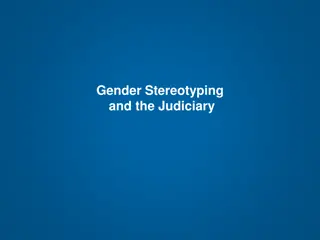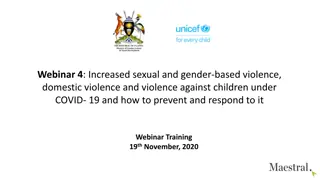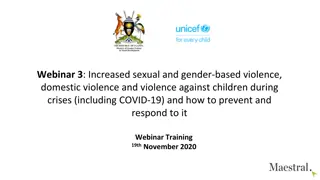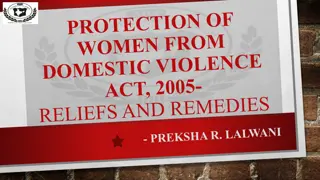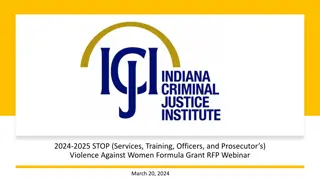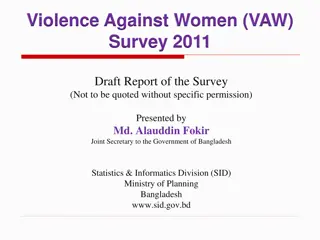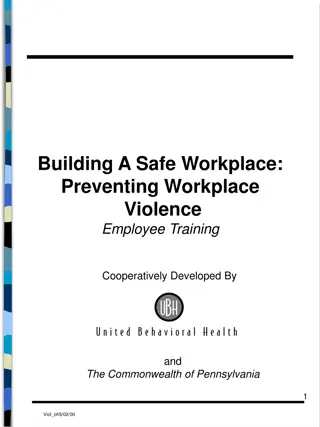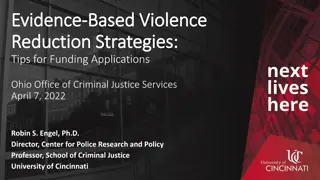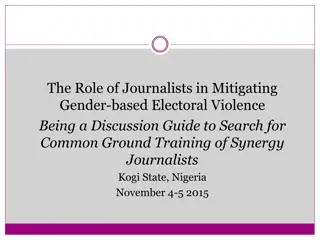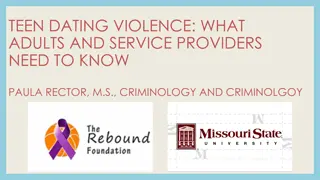Understanding Responses to Rising Violence Trends in the United States
Patrick Sharkey, a professor of Sociology, analyzes the historical trends of violence in the United States, highlighting peaks and declines over the decades. The data from 1960 to 2020 reveal spikes in violence during the 1960s and early 1990s, followed by a downward trend until the mid-2010s. However, a resurgence in violence from 2014 onwards, particularly affecting disadvantaged communities, prompts a call for new approaches to address urban inequality and gun prevalence. Sharkey suggests a model that invests in community organizations alongside traditional law enforcement methods.
Download Presentation

Please find below an Image/Link to download the presentation.
The content on the website is provided AS IS for your information and personal use only. It may not be sold, licensed, or shared on other websites without obtaining consent from the author. Download presentation by click this link. If you encounter any issues during the download, it is possible that the publisher has removed the file from their server.
E N D
Presentation Transcript
Responses to rising violence Patrick Sharkey William S Tod Professor of Sociology and Public Affairs, Princeton School of Public and International Affairs
12 10 8 Homicides per 100,000 6 4 2 0 1992 1994 1966 1968 1996 1998 1960 1962 1964 1976 1990 2020 1970 1972 1974 1978 2006 2018 2000 2002 2004 2010 2016 2008 2012 2014 1980 1984 1986 1982 1988 FBI Uniform Crime Reports
Trends in US violence 1. Falling violence, with fluctuations, throughout most of the nation s history through the 1950s 2. Rising violence in the 1960s, followed by sustained high levels through the early 1990s 3. Falling violence from the early 1990s through the mid 2010s 4. Rising violence from 2014 onward, accelerating in 2020
Sharkey and Marsteller, Neighborhood Inequality and Violence in Chicago, 1965-2020.
Four points 1. Violence has risen sharply from 2014 to the present; the greatest impact has been felt in the most disadvantaged communities 2. Our nation s response to extreme urban inequality, combined with rising prevalence of guns, creates the conditions for high levels of violence 3. Relying on police and the prison can reduce violence, but it comes w great costs and weakens, rather than strengthens, communities 4. A different model, which invests in community organizations and includes police, has substantial evidence behind it
Four points 1. Violence has risen sharply from 2014 to the present; the greatest impact has been felt in the most disadvantaged communities 2. Our nation s response to extreme urban inequality, combined with rising prevalence of guns, creates the conditions for high levels of violence 3. Relying on police and the prison can reduce violence, but it comes w great costs and weakens, rather than strengthens, communities 4. A different model, which invests in community organizations and includes police, has substantial evidence behind it
Justice The inequality and injustice narrative Abandonment Investment The lawlessness and disorder narrative Punishment Sharkey, Uneasy Peace
Concentrated disadvantage Disinvestment Urban inequality Violent crime Institutional decline Collective efficacy Sharkey and Sampson (2015). Violence, Cognition, and Neighborhood Inequality in America. Social Neuroscience: Brain, Mind, and Society.
Four points 1. Violence has risen sharply from 2014 to the present; the greatest impact has been felt in the most disadvantaged communities 2. Our nation s response to extreme urban inequality, combined with rising prevalence of guns, creates the conditions for high levels of violence 3. Relying on police and the prison can reduce violence, but it comes w great costs and weakens, rather than strengthens, communities 4. A different model, which invests in community organizations and includes police, has substantial evidence behind it
Four points 1. Violence has risen sharply from 2014 to the present; the greatest impact has been felt in the most disadvantaged communities 2. Our nation s response to extreme urban inequality, combined with rising prevalence of guns, creates the conditions for high levels of violence 3. Relying on police and the prison can reduce violence, but it comes w great costs and weakens, rather than strengthens, communities 4. A different model, which invests in community organizations and includes police, has substantial evidence behind it
Average Exposure to Violent Crime of Poor and Non-Poor City Residents GROWTH OF POLICE PER CAPITA Chalfin and McCrary (2013). Are U.S. Cities Underpoliced? Theory and Evidence.
MASS INCARCERATION Oliver Roeder, The Imprisoner s Dilemma. FiveThirtyEight.com
Four points 1. Violence has risen sharply from 2014 to the present; the greatest impact has been felt in the most disadvantaged communities 2. Our nation s response to extreme urban inequality, combined with rising prevalence of guns, creates the conditions for high levels of violence 3. Relying on police and the prison can reduce violence, but it comes w great costs and weakens, rather than strengthens, communities 4. A different model, which invests in community organizations and includes police, has substantial evidence behind it
Four points 1. Violence has risen sharply from 2014 to the present; the greatest impact has been felt in the most disadvantaged communities 2. Our nation s response to extreme urban inequality, combined with rising prevalence of guns, creates the conditions for high levels of violence 3. Relying on police and the prison can reduce violence, but it comes w great costs and weakens, rather than strengthens, communities 4. A different model, which invests in community organizations and includes police, has substantial evidence behind it
GROWTH OF ANTI-VIOLENCE NONPROFITS Yearly growth in anti-violence nonprofits per 100,000 Sharkey, Torrats-Espinosa and Takyar, Community and the Crime Decline: The Causal Effect of Local Nonprofits on Violent Crime. American Sociological Review.
WHAT ROLE DID COMMUNITY ORGANIZATIONS PLAY IN THE CRIME DECLINE? In a city of 100,000 residents, every 10 additional nonprofits focused on crime/community led to a 9% drop in murder, a 6% drop in violent crime and 4% drop in property crime rates. Sharkey, Torrats-Espinosa and Takyar, Community and the Crime Decline: The Causal Effect of Local Nonprofits on Violent Crime. American Sociological Review.
EVIDENCE ON THE IMPACT OF LOCAL PROGRAMS Cognitive behavioral therapy plus after-school sports reduced arrests for violent crimes by 45-50% (Heller et al. 2016) Summer jobs and youth programming reduced violence by 43% over 16 months (Heller 2014) Establishment of business improvement districts reduced violence by 11% (Cook and MacDonald 2011) Redesigning abandoned buildings/plots of land reduced violence by 29% in high-poverty neighborhoods (Branas et al. 2018)
Four points 1. Violence has risen sharply from 2014 to the present; the greatest impact has been felt in the most disadvantaged communities 2. Our nation s response to extreme urban inequality, combined with rising prevalence of guns, creates the conditions for high levels of violence 3. Relying on police and the prison can reduce violence, but it comes w great costs and weakens, rather than strengthens, communities 4. A different model, which invests in community organizations and includes police, has substantial evidence behind it



